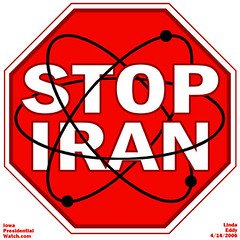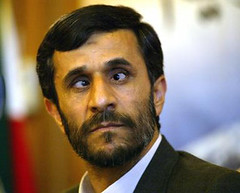Hat Tip "Peter"
Alliance Against America: Al Qaeda and Iran
Obama's strong ties and support of Islamic Iran is possibly treasonous, if not, certainly treacherous!
Iran (Shia) and Al Qaeda (Sunni) seem like unlikely bedfellows given the Shia-Sunni divide that often exists in Islamic society. This divide, however, has not precluded cooperation in certain conditions, as the two have found "common cause in their mutual hatred of America; both can see the virtue in having more anti-U.S. violence, whatever the source."
Iran has collaborated with Al Qaeda covertly and often by proxy due to the latter's notorious reputation. This covert cooperation began in the early 1990's in Sudan, continued after Al Qaeda relocated to Afghanistan, and even manifested itself on Iranian soil before, during, and after the September 11 attacks. Although such cooperation has been known by authorities, for the first time in July 2011 the U.S. formally accused Iran of forging an alliance with Al-Qaeda that includes harboring Al-Qaeda operatives on Iranian territory and helping Al-Qaeda transit money, weapons and fighters.
This Alliance Against America between the world's leading state sponsor of terrorism and the most infamous international terrorist group is a formidable and menacing threat to American interests.
This report documents the development of the Iran - Al Qaeda alliance from the early 1990's to the present day. SOME OF THE INDIVDUALS ARE NOW DECEASED)
1992-1996
Origins: Iran, Al Qaeda and Hezbollah
Ties between Iran and Al Qaeda began in the early 1990's when Hasan Al Turabi and Osama Bin Laden (pictured) met in Sudan.
Iran - Al Qaeda links are not new. Ties between the two were initiated in the early 1990's when Hasan Al-Turabi, the leader of Sudan's National Islamic Front, began to encourage Sunni-Shia reconciliation in order to defeat the common enemy, namely America and its allies. According to the U.S. court record for the 1998 U.S embassy bombings, Osama was living in Khartoum when the Sudanese religious scholar Ahmed Abdel Rahman Hamadabi brought Sheikh Nomani, representing the Iranian Shias, to meet the Al Qaeda leadership. Sheikh Nomani "had access to the highest echelons of power in Tehran."
As a result of this meeting, "Iran and Al Qaeda reached an informal agreement to cooperate, with Iran providing critical explosives, intelligence, and security training to bin Laden's organization." This meeting was the first in a series of meetings between Iran and Al Qaeda.
The 9/11 Commission Report has a section devoted exclusively towards investigating Iranian ties to Al Qaeda entitled, "Assistance from Hezbollah and Iran to Al Qaeda." The report states that shortly after these meetings in Sudan in late 1991 or 1992, "senior Al Qaeda operatives and trainers traveled to Iran to receive training in explosives. In the fall of 1993, another such delegation went to the Bekaa Valley in Lebanon for further training in explosives as well as in intelligence and security.
Bin Laden reportedly showed particular interest in learning how to use truck bombs such as the one that had killed 241 U.S. Marines in Lebanon in 1983. The relationship between Al Qaeda and Iran demonstrated that Sunni-Shia divisions did not necessarily pose an insurmountable barrier to cooperation in terrorist operations."
Hezbollah, founded in 1982 at the behest of the IRGC, has acted as a key intermediary between Iran and Al Qaeda
Iran and Hezbollah function in a patron-client relationship. The Islamic Revolutionary Guard Corps (IRGC) supported Hezbollah operationally and financially amidst the turmoil of the Lebanese Civil War in the early 1980's, enabling it to develop into a deadly and proficient organization. Creating and maintaining Hezbollah was not only useful to export the Islamic Republic's revolutionary ideology; it also provided Iran a convenient terrorist proxy through which Iran could operate with impunity.
As such, Iran was able to limit the risks of cooperating with Al Qaeda directly by engaging Al Qaeda through Hezbollah. After the Khartoum meeting with Sheihk Nomani, "Iran consulted Hezbollah and Al Qaeda was invited to send a contingent to Lebanon." Not only did Al Qaeda come out of Lebanon with "training and propaganda videos," it also received "a large amount of explosives from Iran that were used in the bombing of the East African targets."
Additionally, it was Imad Mugniyeh (Hezbollah's recently assassinated military chief) "who inspired Osama to develop coordinated, simultaneous attacks as a regular modus operandi, and this has been the hallmark of most subsequent Al Qaeda operations." And even more, "Both Hezbollah trainers and experts from Iran's Ministry of Information and Security trained Al Qaeda fighters in Sudan (in existing Al Qaeda facilities), Lebanon (in Hezbollah camps) and Iran (in officially run bases.)"
1996-2000
Consolidation: Iran Strengthens Ties with Al Qaeda in Afghanistan
Following the bombing of the USS Cole (pictured) in 2000, Iran attempted to strengthen its relations with Al Qaeda.
After Al-Qaeda's banishment from Sudan in response to its unsuccessful attempt to assassinate Egyptian President Hosni Mubarak and its subsequent relocation to Afghanistan in 1996, Iran continued to provide assistance Al-Qaeda with assistance.
Iran facilitated travel for Al-Qaeda fighters through Iran to Afghanistan and "Iranian border guards were instructed not to stamp their passports, presumably to prevent their home governments from suspecting that they had traveled to Afghanistan." As evidence of this burgeoning relationship, it is reported that between 1996 and 1998, nearly 10 percent of Osama Bin Laden's outgoing calls were to Iran.
Iran was eager to cooperate with Al Qaeda, although Osama bin Laden was somewhat reluctant. The 9/11 Commission Report states, "Intelligence indicates the persistence of contacts between Iranian security officials and senior Al-Qaeda figures after Bin Laden's return to Afghanistan… Iran made a concerted effort to strengthen relations with Al Qaeda after the October 2000 attack on the USS Cole, but was rebuffed because Bin Laden did not want to alienate his supporters in Saudi Arabia."
U.S authorities were well aware of this relationship at the time. The 9/11 Commission Report states, "On November 4, 1998, the U.S. Attorney's Office for the Southern District of New York unsealed its indictment of bin Laden, charging him with conspiracy to attack U.S. defense installations. The indictment also charged that Al-Qaeda had allied itself with Sudan, Iran, and Hezbollah."
2001
A Dark Day: Iran's Role in the September 11 Attacks
On September 11, 2001, terrorists hijacked four commercial airliners, intentionally crashing two into the Twin Towers of the World Trade Center in New York and one into the Pentagon in Washington, D.C. The fourth plane crashed in a field in rural Pennsylvania. Nearly 3000 victims were murdered. Authorities quickly traced the attacks to Al Qaeda.
The 9/11 Commission Report states that “there is strong evidence that Iran facilitated the transit of Al Qaeda members into and out of Afghanistan before 9/11.” New evidence from defectors of Iran’s intelligence service suggests Iran had an even more direct role in the attacks.
The 9/11 Commission's chapter, "Assistance from Hezbollah and Iran to Al Qaeda," documents Iran's facilitation of transit for Al Qaeda members from 2000-2001. After listing various examples, the report states, "In sum, there is strong evidence that Iran facilitated the transit of Al Qaeda members into and out of Afghanistan before 9/11, and that some of these were future 9/11 hijackers. There is also circumstantial evidence that senior Hezbollah operatives were closely tracking the travel of some of these future muscle hijackers into Iran in November 2000."
At the same time, the report asserts, "We have found no evidence that Iran or Hezbollah was aware of the planning for what later became the 9/11 attack…We believe this topic requires further investigation by the U.S. government."
Further investigation has indeed revealed evidence suggesting Iran was aware of the planning for 9/11. According to The New York Times, "two defectors from Iran's intelligence service have testified that Iranian officials had ‘foreknowledge of the 9/11 attacks,'" and one of the defectors also "claimed that Iran was involved in planning the attacks."
Those defectors have been called as witnesses in a case brought by families of the victims of the September 11 attacks. "The court papers also include sworn statements from staff members of the 9/11 Commission, including Dietrich Snell, a former top terrorism prosecutor at the Justice Department, who states in his affidavit that ‘there is clear and convincing evidence the government of Iran provided material support to Al Qaeda in the planning and execution of the 9/11 attack. He said the support came in the form of facilitating the travel of members of the 9/11 conspiracy to and from Afghanistan and Pakistan."
Suspected Iranian collaboration with Al Qaeda in planning or executing the September 11 attacks is a serious charge. Iran's complicity in this catastrophe must be properly investigated in light of Iran's past and current relationship with Al Qaeda. The current court case brought by families of the victims of the 9/11 attacks is a step in the right direction.
Escape from Afghanistan
Ayman al-Zawahiri’s (pictured) relationship with the Iranian leadership was instrumental in achieving safe harbor in Iran for Al Qaeda operatives during the U.S. invasion of Afghanistan.
After the launch of Operation Enduring Freedom in October 2001 in response to the September 11 attacks, it is common knowledge that many members of Al-Qaeda, including Osama bin Laden, fled to the lawless Federally Administered Tribal Areas of Western Pakistan.
What is less known is that key elements of Al-Qaeda also escaped to Iran, in some cases with assistance from Iranian authorities.
For example in 2003, The Washington Post reported on a "decade-old relationship" between Ayman al-Zawahiri, then Al-Qaeda's second-in-command, and Ahmad Vahidi, Iran's current Minister of Defense.
In 2001, Vahidi, then commander of the IRGC's elite Quds Force, reportedly provided "safe harbor for some Al Qaeda leaders who were trapped in the mountains of Tora Bora" following negotiations with al-Zawahiri. According to a European intelligence analyst, "The [Quds] Force's senior leaders have longstanding ties to Al Qaeda, and since the fall of Afghanistan, have provided some Al Qaeda leaders with travel documents and safe haven."
Under such arrangements, key members of Al Qaeda's operational structure came to reside in Iran, including such infamous figures as Saif al-Adel (Security Chief), Sa'ad bin Laden (Osama's son, Senior Operative), Abdullah Ahmed Abdullah (CFO of AQ) and Abu Musab al-Zarqawi (then Chief of AQ in Iraq).
Nominally, Iran held these Al Qaeda operatives under "house arrest," but in reality, Al Qaeda was using Iran as a base of operations under the protection of the Quds Force. By providing Al Qaeda operatives such sanctuary, Iran has been in direct violation of UN Security Council Resolution 1390, which prohibits the harboring of Al Qaeda members.
Over the next decade, as a means to further its own regional goals, the Iranian regime would permit Al Qaeda use of its territory to plan terrorist attacks abroad as well as transit money, arms and fighters across the region.
2002-2010
Continuity: Iran's Covert Support for Al Qaeda Since 9/11
After the international community made the dissolution of Al Qaeda a top priority, Iran downplayed its ties to the organization and at times portrayed itself as Al Qaeda's enemy. However, according to Matthew Levitt and Michael Jacobson, analysts at the Washington Institute for Near East Policy, "this seemingly tough stance served as cover for Tehran's ongoing dealings with the organization; the regime's support for Al Qaeda continued throughout this period."
In 2010, General David Petraeus, as Commander of U.S. Central Command, reported that Al Qaeda "continues to use Iran as a key facilitation hub, where facilitators connect Al Qaeda's senior leadership to regional affiliates."
Iran's Harboring of Al Qaeda
Since 2001, Iran has harbored key Al Qaeda operatives.
In its 2007 "Country Reports on Terrorism," the U.S. State Department wrote that "Iran remained unwilling to bring to justice senior Al Qaida members it has detained, and has refused to publicly identify those senior members in its custody. Iran has repeatedly resisted numerous calls to transfer custody of its AQ detainees to their countries of origin or third countries for interrogation or trial. Iran also continued to fail to control the activities of some AQ members who fled to Iran following the fall of the Taliban regime in Afghanistan."
In January 2009, the U.S. Treasury Department froze the assets of four key Al Qaeda operatives based in Iran, including Osama's eldest son Sa'ad bin Laden. Regarding the action, Under Secretary for Terrorism and Financial Intelligence Stuart Levey stated, "It is important that Iran give a public accounting of how it is meeting its international obligations to constrain al Qaeda."
In fact, as reported as far back as 2003, since Sa'ad's "arrival in Iran… he has assumed a more active role in directing al Qaeda, and he has been identified as a senior leader." It is believed that Iran allowed Sa'ad to relocate to Pakistan in late 2008.
Saif al-Adel (pictured), the alleged Al Qaeda mastermind of the 1998 U.S. embassy bombings, is reportedly based in Iran.
In March 2010, Al Qaeda assisted Iran in negotiating the return of an Iranian diplomat who had been held captive by the Taliban in Pakistan for 15 months. This incident pointed to another dangerous sign of increased Iran-Al Qaeda collaboration. In return for its help, Iran provided Al Qaeda operatives based in its territory greater freedom of movement and loosened restrictions.
As one example, Al Qaeda's chief military strategist that lives in Iran, Saif al-Adel, was allowed to travel to Pakistan and open more contacts with other Al Qaeda leaders. Remaining in Iran while possessing the freedom to travel "suggests that al-Adel and perhaps lower level Al-Qaeda figures now consider Iran a viable outpost, with fewer restrictions…" Furthermore, the "apparent easing of Iran's restrictions on Al Qaeda… now opens up speculation that al-Adel could establish a ‘satellite office' for the group in Iran."
Terrorist Operations
From its Iranian safe haven, Al Qaeda members have planned terrorist operations that have killed dozens of people, including Americans.
Aftermath of the 2003 Riyadh compound bombings (pictured), reportedly planned and ordered by Al Qaeada operatives in Iran. 35 people died in the attack, including 8 Americans.
For example, on May 12, 2003, Al Qaeda commandos attacked residential compounds housing foreign workers in Riyadh, Saudi Arabia, killing 35 people, including 8 Americans. The attacks were reportedly planned and ordered by Al Qaeda operatives in Iran, specifically Saif al-Adel and Sa'ad bin Laden. Through the UN, the U.S. conveyed its "deep concern that individuals associated with Al Qaeda have planned and directed the attack in Saudi Arabia from inside Iran."
According to intelligence sources, Sa'ad was also involved in planning the April 11, 2002 suicide bombing of a Tunisian synagogue on April 11, 2002 that left 21 dead.
An intercepted letter reportedly sent to the IRGC in 2008 by Ayman al Zawahiri, Al Qaeda's current leader, revealed an even deeper relationship between Iran and Al Qaeda than previously thought.
The correspondence was sent after the September 19, 2008 attacks on the American embassy in Sana'a, Yemen, which killed 19 people. The Daily Telegraph states, "In the letter, Al-Qaeda's leadership pays tribute to Iran's generosity, stating that without its ‘monetary and infrastructure assistance' it would have not been possible for the group to carry out the terror attacks. It also thanked Iran for having the ‘vision' to help the terror organization establish new bases in Yemen after Al-Qaeda was forced to abandon much of its terrorist infrastructure in Iraq and Saudi Arabia."
Al Qaeda in Iraq
Iran’s safe harbor for Abu Musab al-Zarqawi (pictured) gave him the opportunity to set up Al Qaeda in Iraq.
Following the U.S. invasion of Afghanistan, Iran also provided safe haven to Al Qaeda operative Abu Musab al-Zarqawi, who went on to establish Al Qaeda in Iraq, an Al Qaeda offshoot that went on to kill untold numbers of Iraqis and Americans.
Zarqawi initially operated under the protection of the IRGC and its elite Quds Brigade. According to intelligence officials, the time Zarqawi spent in Iran was crucial for rebuilding his network before relocating to Iraq. While the Iranian regime eventually succumbed to U.S. pressure, forcing Zarqawi to leave Iran and arresting many of his personnel, the damage had already been done: Zarqawi's network was already rebuilt, even though the Iranian authorities could have prevented such an outcome at any time.
Iran's support for Zarqawi and other Al Qaeda leaders belies the assumption made by individuals in the intelligence community that Iran's arrest and deportation of Al Qaeda members underscored Iran's cooperation in the U.S.'s War on Terror. In the words of terrorism analyst Thomas Joscelyn, "Iran's behavior can be explained by way of analogy. Like a corrupt cop in league with the mob, the Iranians have been willing to clamp down and turn over small-time operatives, while allowing bigger players to operate with impunity." Iran provided Zarqawi with such operational impunity.
Joint Operations
Iran reportedly brokered an arms deal between North Korea and Gulbuddin Hekmatyar (pictured), an Afghan militant leader affiliated with Al Qaeda.
Recently leaked documents from U.S. military intelligence "outline Iran's alleged role in brokering arms deals between North Korea and Pakistan-based militants, particularly militant leader Gulbuddin Hekmatyar and Al Qaeda."
In this deal, Hekmatyar reportedly departed from Iran to North Korea in 2005 "to close a deal with the North Korean government to obtain remote-controlled rockets to use against coalition aircraft in Afghanistan." Further intelligence reports revealed a 2006 "Al Qaeda-Hekmatyar plot to equip suicide bombers and car bombs to attack Afghan government and international targets - using cars and equipment obtained in Iran."
And lastly, an April2007 report detailed an operation in which "Al Qaeda, ‘helped by Iran,' bought 72 air-to-air missiles from Algeria and hid them in Zahedan, Iran, in order to later smuggle them into Afghanistan."
2011
Recognition: U.S. Acknowledges Iran-Al Qaeda Alliance
While the relationship between the Iran and Al Qaeda has long been pubic knowledge, until recently the U.S. government had hesitated to formally link the two entities. This changed on July 28, 2011, when "the U.S. for the first time formally accused Iran of forging an alliance with Al Qaeda in a pact that allows the terrorist group to use Iranian soil as a transit point for moving money, arms and fighters to its bases in Pakistan and Afghanistan."
The Treasury Department has evidence of an extensive fund-raising operation that draws from donors in Persian Gulf countries such as Kuwait and Qatar and uses Iran-based Al Qaeda operatives. Six Al Qaeda members were sanctioned for overseeing this network, headed by Syrian national Ezedin Abdul Aziz Khalil.
The Treasury designation is particularly notable because it accuses Iran of being "an important link in Al Qaeda's financing and recruitment." It also states that the relationship dates back to 2005.
David Cohen, the Treasury Department's Undersecretary for Terrorism and Financial Intelligence said, "By exposing Iran's secret deal with Al Qaeda allowing it to funnel funds and operatives through its territory, we are illuminating yet another aspect of Iran's unmatched support for terrorism."
Conclusion: A Long-Standing Alliance Against America
Beginning in the early 1990's, Iran and Al Qaeda initiated their Alliance Against America - a partnership that would only intensify over time. Prior to the September 11 attacks, Iran, primarily through its proxy Hezbollah, provided Al Qaeda critical training, explosives and logistical support. Such support culminated in Iran facilitating the transit of some of the 9/11 hijackers through its territory.
Following the September 11 attacks, Iran portrayed itself as an enemy of Al Qaeda, but in reality their relationship became even more deeply rooted. The Iranian regime, via the IRGC's elite Quds Force, provided key members of Al Qaeda's leadership safe haven in Iran to continue their terrorist operations and avoid arrest by international authorities. Some Al Qaeda operatives continue to reside in Iran.
With formal U.S. recognition in July 2011 that Iran has forged an alliance with Al Qaeda, it is time that the U.S. government and its citizens recognize this Alliance Against America and demand that the Iranian regime stop providing sanctuary to one of America and the international community's deadliest foes.
Al Qaeda Leaders That Have Resided/Traveled in Iran
Name: Ayman al-Zawahiri
Position: Head of Al Qaeda
Connection: Zawahiri, the current leader of Al Qaeda, has long maintained ties to Iran. Throughout the 1990's, as the leader of Egyptian Islamic Jihad, Zawahiri was a frequent guest in Iran of Ali Fallahian, Iran's then-Minister of Intelligence, and Ahmad Vahidi, then-head of the IRGC's Quds Force. In 2003, The Washington Post reported on this "decade-old relationship" between Zawahiri and Vahidi, who had since become Iran's Minister of Defense. Zawahiri's relationship with Vahidi was reportedly instrumental in achieving safe harbor for Al Qaeda operatives seeking sanctuary from the U.S. invasion of Afghanistan in 2001.
Name: Saif al-Adel
Position: Chief of Military Operations of Al Qaeda
Connection: Saif al-Adel disappeared after 9/11 and later re-emerged in Iran with other leading Al Qaeda members under the protections of the Quds Force. From Iran, al-Adel masterminded terrorist attacks abroad. In 2010, al-Adel and other Al Qaeda operatives based in Iran were provided greater freedom of movement and loosened restrictions in return for the release of an Iranian diplomat from Taliban custody. While al-Adel used these new freedoms to travel to Pakistan, he has reportedly remained in Iran to oversee Al Qaeda operations.
Name: Saad Bin Laden
Position: Senior Al Qaeda Operative, Terrorist Operations Planner
Connection: Under the auspices of the Quds Force, Saad reportedly fled to Iran to escape the U.S.-led invasion of Afghanistan. In Iran, he assumed a more senior and active role in Al Qaeda, including planning terrorist operations abroad. As of 2008, the U.S. government believes Saad may have relocated to Pakistan with the agreement of Iran.
Name: Abu Musab al-Zarqawi (Deceased)
Position: Head of Al Qaeda in Iraq
Connection: Before going to lead Al Qaeda in Iraq, Iran provided safe haven to Zarqawi following the U.S. invasion of Afghanistan. Before being removed from the country, Zarqawi operated under the protection of the IRGC's Quds Force. The time Zarqawi spent in Iran was crucial for rebuilding his network before relocating to Iraq.
Name: Abdullah Ahmed Abdullah
Position: Chief Financial Officer of Al Qaeda
Connection: Abdullah, one of Al Qaeda's top operational deputies, reportedly arrived in Iran shortly after the U.S. invasion of Afghanistan under the protection of the IRGC's elite Quds Force. He is believed to currently be in tribal areas of Afghanistan or Pakistan.
Name: Suleiman Abu Ghaith
Position: Official Al Qaeda Spokesman
Connection: The notorious Kuwaiti preacher reportedly arrived in Iran in early 2002. In 2010, Iran reportedly allowed Abu Ghaith to return to Afghanistan in exchange for an Iranian diplomat who was kidnapped by the Taliban in Pakistan in 2008.
Subscribe to:
Post Comments (Atom)

























No comments:
Post a Comment